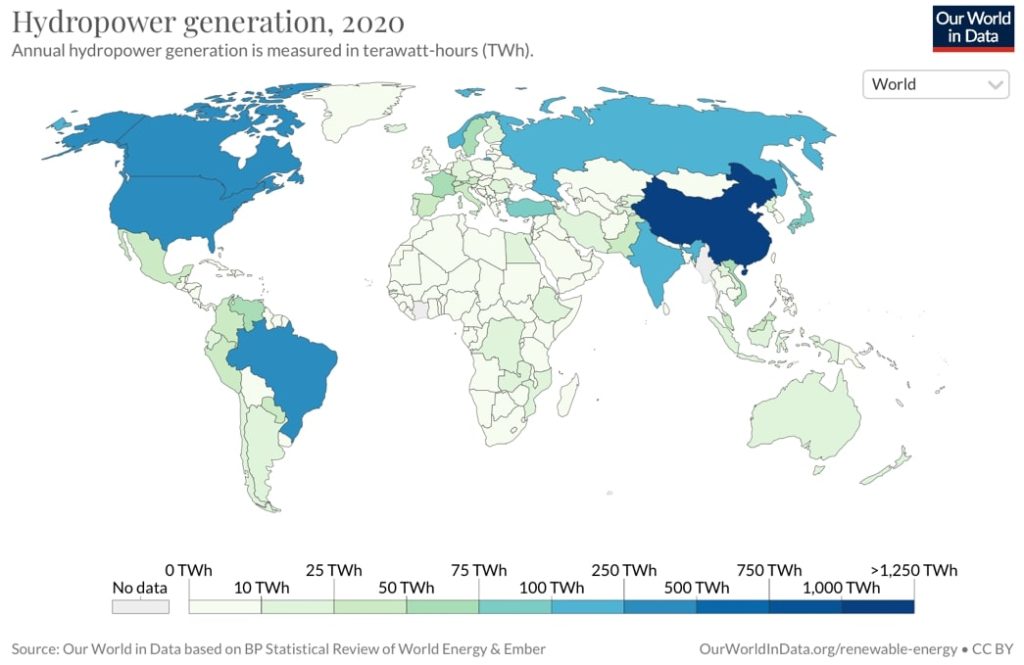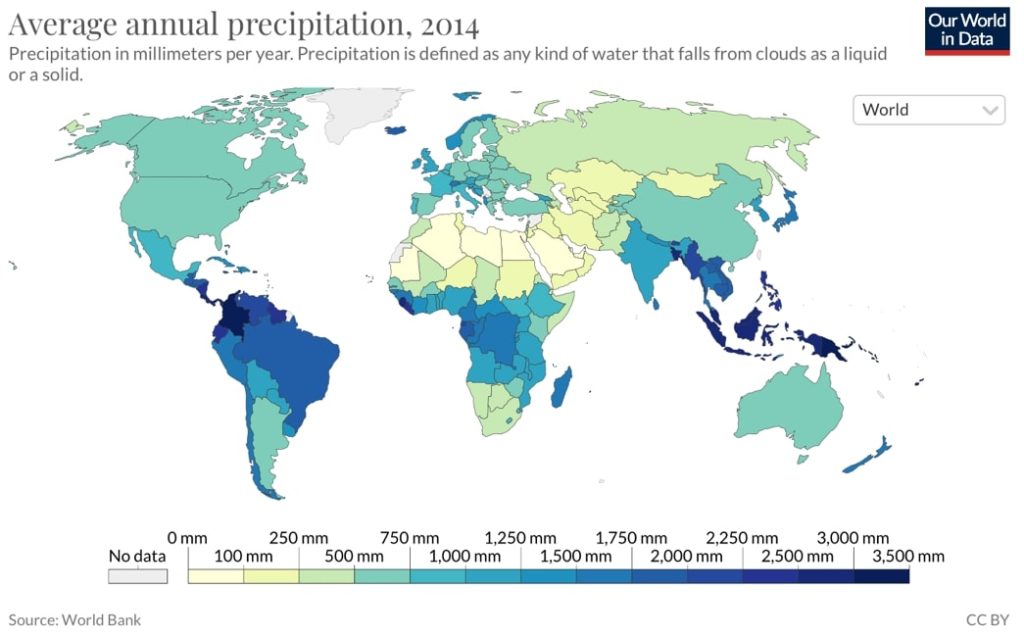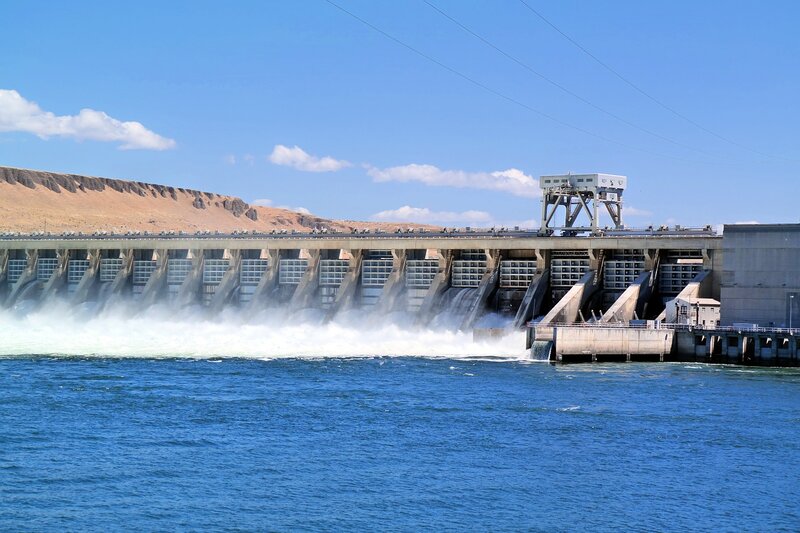In recent years, there has been a growing focus on sustainability and the environment. Burning fossil fuels is arguably the biggest cause of the climate crisis, and renewable energy can fill the gap that ending the use of fossil fuels will leave. By 2019, the global consumption of primary energy from renewable sources increased to 11.4%, from 7% in 2000. Of all renewable energy sources, hydroelectric power represents the largest share of renewable energy in the world. How is it distributed around the world?
—
Hydroelectric power converts kinetic energy of the falling water into mechanical energy through the rotation of turbines. Generators then convert the mechanical energy into electrical energy that is used by the public.
In 2019, the global share of energy from hydroelectric power out of all forms of energy sources (including fossil fuels) was 6.45%, increasing from 6.08% in 2007. Furthermore, of all renewables, hydroelectric power constituted 60.08% of the renewable energy mix in 2019.
Interestingly, there has been a trend where developing countries are utilising or engaging in the establishment of hydroelectric power more than the developed countries. As seen in Figure 1 below, hydropower generation is generally greater in developing countries, including in China, South America and Africa.
You might also like: New Wind, Solar Projects Will Be Cheaper Than Coal- Report

Figure 1: Hydropower Generation in 2020 (Source: Our World in Data)
One of the factors in this may be the greater precipitation rate in developing countries. From Figure 2 below, we can see that precipitation rates are generally higher in tropical and subtropical regions, which are generally developing countries. This suggests a correlation between the average annual precipitation rate and share of electricity production from hydropower.

Figure 2: Global Average Annual Precipitation (mm per year) (Source: Our World in Data)
Significantly, a 2017 study discovered that a 43% increase in precipitation results in an approximately 39% increase in electricity production from hydropower plants. This strongly indicates a relationship between electricity production of hydropower plants and precipitation.
Another reason to explain developing countries’ high utilisation of hydroelectric power is “South to South Investment,” trade, a trade cooperation between developing countries. The investment and trade focuses on the installation, innovation and dissemination of technologies and knowledge of hydroelectric power plants. For example, the trade of hydraulic turbines and parts, and of the knowledge and technology required to convert hydropower into electricity.
You might also like: Examining the Pros and Cons of Hydroelectric Energy
“South to South Investment” is an important source in supporting the technology and financial transfer of hydropower, especially for developing countries. From 2004 to 2012, the trade in equipment and parts of hydropower increased from less than 10% to approximately 50% of total global trade. Through this channel of investment and trade, developing countries can successfully obtain the equipment and knowledge required to help them efficiently transfer hydropower into electricity they need.
Furthermore, the increasing global call for the reduction of burning fossil fuels has pressured countries to transition to renewable energy. However, developing countries face obstacles. Most developing countries have a high energy demand due to its industrial nature, such as its manufacturing and energy intensive industries. Thus, developing countries aim to transition to a renewable energy that can support its high energy demands.
Compared to other forms of renewable energy, such as wind or solar energy, hydropower is least affected by the seasons and weather as it stores water through its dam. Meanwhile, solar and wind energy, which is highly dependent on the weather, may be unable to generate enough energy for its manufacturing industries as it is unable to store high amounts of sun and wind energy prior. Hydroelectric power can store large amounts of water through its dam, making it relatively less reliant on the weather.
Hydropower also has a greater efficiency than other forms of renewable energy. The global weighted average capacity factor of hydropower was 47% in 2017. This value was greater than the approximated 20% of wind energy and 15% of solar power. The capacity factor refers to the ratio of energy that can be produced by the power generator in a given period. This implies that hydropower can convert the greatest amount of energy in the same time period compared to other renewables.
The trend where developing countries utilise hydropower energy more can also be observed from the growth of hydropower generation. In recent years, the two countries with the highest growth of hydropower generation were China and Brazil, both developing countries.
China observed a 56-fold increase in hydropower generation, from 22.10 TWh in 1965 to 1269.67 TWh in 2019, while Brazil recorded an increase from 25.52 TWh in 1965 to 399.30 TWh. Both China and Brazil are becoming the rising global leaders of hydropower, with China currently being the indisputable leader.
Looking at China as an example, it recorded the greatest hydropower generation in 2020 with 1355.2TWh. Pumped storage hydropower has been observed as an essential component in providing flexibility to the country’s power system. China has been implementing reforms and policies to aid in the transition to renewables and to commit to its goal of becoming carbon neutral by 2060. Hydropower has continued to be a priority in the energy transition in China.
China has also displayed active engagement in the “South to South” trade and investment scheme through its One Belt One Road (OBOR) initiative. The country has continued to invest in major hydropower projects internally and overseas. In 2019, 7 out of the top 10 largest hydropower dams were located in China, with the Three Gorges Dam in Yangtze River being first. In the coming few years, it is expected that there will be new hydropower projects including Wudongde and Baihetan in Jinsha River, and many more projects.
Another interesting example is Brazil, who generates 74% of all the country’s electricity from hydropower. Osvaldo San Martin, the president and CEO of Voith Hydro Latin America notes that the “untapped hydropower potential is still huge and renewable energy continues to be one of the region’s most valuable assets.” Significantly, he reinforced that the growth of renewables in Brazil will continue to impress, “especially in the new hydropower sector”.
Brazil and several countries in Latin America have government support and incentives that encourage the development and utilisation of renewable energy, including hydropower. Brazil has also established many channels to equip people with knowledge and skills regarding hydropower energy. For example, Alstom – a manufacturing operation company specialising in power plants and equipment – signed partnerships with two universities in Brazil to create degree programmes related to hydropower energy. Alstom is also building the world’s largest hydro manufacturing facility in Brazil, providing them with expertise in areas including turbines, generators, hydro mechanical equipment etc.
However, there are also several disadvantages and limitations to hydroelectric power. The most significant one is the damage to the surrounding environment and ecosystem. Most hydroelectric power plants require the construction of a dam, which would result in the destruction and fragmentation of the surrounding habitats. For example, the construction of these water dams may affect the migration and movement of aquatic organisms, hinder their reproduction, and in some extreme cases, some species may become extinct.
Also, as most of the hydroelectric projects are physically large in size and might result in the flooding of massive areas within a river valley. Yet, with the advancement of knowledge and technology, the negative impact of constructing these hydroelectric plants can possibly be reduced or minimised.
In recent years, developing countries, such as China and Brazil, have shown the greatest positive increase in hydropower generation compared to other developed countries. Thus, we can predict that the trend where developing countries utilise hydropower energy more will continue in the future. As countries continue their transition towards renewable energies in its attempt to reduce the burning of fossil fuels, hydropower energy will continue to be a growing force in clean energy.
You might also like: What the Future of Renewable Energy Looks Like

















